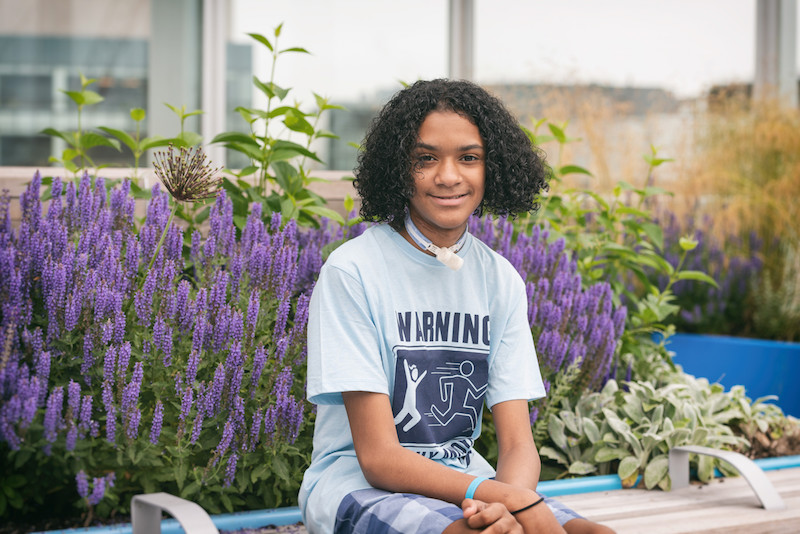Beyond limits: A staged approach to jejunal interposition

By the time Chase Essex arrived at Boston Children’s Hospital in 2016, he had reached what most clinicians would consider the limits of modern medicine. Surgeons at his home hospital had performed nearly three dozen procedures to address damage to his trachea caused by his accidental ingestion of lye years earlier. Yet when it came to his damaged esophagus, they believed they had done all they could. At age 12, Chase was active, but relied on a G-tube for nutrition and hadn’t eaten by mouth since he was a toddler. Worse, the inability to swallow left him constantly spitting into a cup to eliminate excess saliva.
“Chase’s situation is fairly unique because he’s otherwise healthy but has extensive scarring on both his trachea and esophagus,” says Amir Taghinia, MD, a surgeon in Boston Children’s Department of Plastic and Oral Surgery. “We’ve only seen three patients with this amount of scarring from their lips to their stomach.”
No ordinary patient
Chase and his family had traveled from their home in Maryland to see whether the Boston Children’s team could do what surgeons elsewhere could not: Provide the boy with a functioning esophagus. There was good news: Taghinia and his colleagues, plastic surgeon Brian Labow, MD, and Russell Jennings, MD, (surgical director of the Esophageal and Airway Treatment Center), believed that Chase could be a good candidate for jejunal interposition. In this sophisticated procedure, surgeons replace the missing section of a child’s esophagus with a section of the jejunum, the middle part of the small intestine.
The plastic surgery and EAT teams have unmatched experience in performing jejunal interpositions in pediatric patients — but Chase was no ordinary patient. His widespread tissue damage meant that the team needed to not only rebuild his esophagus, but also reduce scarring around his vocal cords to allow the epiglottis to switch back and forth from breathing to swallowing. If the approach failed, Chase would be able to breathe or swallow, but not do both.
A staged approach
Taghinia and Labow recommended a staged approach to reconstruction. In August 2017, they surgically released some of the scarred tissues above Chase’s airway. “We’re experienced in treating burns,” says Labow. “In this situation, the location of the burns was different, but the basic principles were similar.” Next, the pair created a tube of skin taken from Chase’s thigh and then transplanted it into his throat to form the upper part of his esophagus. This seven-hour procedure required reattaching the blood vessels that sustain the thigh skin to recipient blood vessels in his neck, using a microscope.
This temporary tube drained out of Chase’s neck, allowing him to practice drinking and preventing him from having to spit out his saliva. The stepwise tactic served as a test: “We wanted to make sure he wasn’t aspirating,” Labow explains. “This proof of concept was a safe, straightforward way to do that and gave us confidence before taking the next step.” That step, jejunal interposition, took place the following May.
Truly remarkable
Although thigh tissue is commonly used in esophageal reconstruction for cancer patients, Labow and Taghinia had never applied the technique so close to a child’s vocal cords or airway. Now, they hope to use the same type of approach for other children with severe esophageal damage. “As plastic surgeons, a lot of what we do is obvious, like facial and hand reconstructions,” says Labow. “But some of our work is hidden inside a child’s body. Chase is a great example of that.”
Indeed, the staged approach to jejunal interposition has allowed Chase to finally enjoy eating by mouth. “The way Chase is now is truly remarkable,” says Taghinia. “We were hopeful that the outcome would be positive, but we didn’t think that pizza and ice cream would be in his future. It’s like winning the lottery twice — he’s a really dynamic kid.”
Learn about the Department of Plastic and Oral Surgery and the Esophageal and Airway Treatment (EAT) Center. Read more about Chase’s story.
Related Posts :
-

One day closer: Second opinion for urologic pain changes Iker’s life at last
Like many kids, Iker Guzman enjoys playing with LEGO toys. But there was nothing lighthearted about the day a few ...
-

Rowan the Remarkable: Defying the odds with CPAM
This is the story of a baby named Rowan and his remarkable journey of beating the odds after doctors discovered ...
-

Surgery beats sclerotherapy for rectal prolapse in children ages 5 and older
Rectal prolapse — the protrusion of the lining of a child’s rectum through the anal sphincter — can occur for many ...
-

The best decision: Triplet Jayden is thriving after CDH repair
Jayden is barely a year old, but he’s already been through more ups and downs than some adults. Born ...





